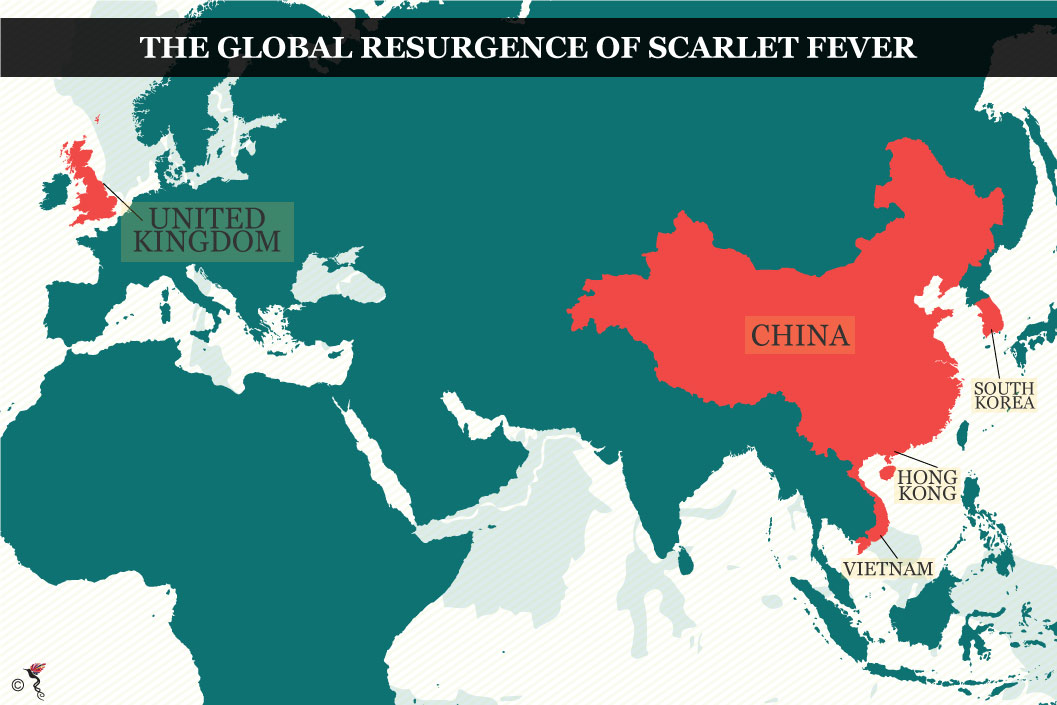After years and years of decline, scarlet fever, the disease that once struck fear into the hearts of parents is once again hitting United Kingdom and some parts in Asia and in Southeast Asia, specifically Vietnam.
Scarlet fever, a common cause of childhood death in the 1800s and early 1900s, has seen an upsurge in England since 2011, scientists said last Tuesday in The Lancet Infectious Diseases, a leading medical journal.
Identifying the cause for the increased cases was "a public health priority", they warned.
The number of cases tripled from 2013 and continued to increase in 2015 and 2016, with England and Wales last year recording the highest number of cases there in a half-century.
In 2014, that amounted to a scarlet fever notification "for one in 500 children under the age of 10 years." There were no deaths.
Similar and in some cases even larger surges of scarlet fever have been reported in recent years in South Korea, Vietnam, China, and Hong Kong. Hong Kong, which saw a tenfold rise in cases, continues to report increased annual counts five years after the resurgence was first noticed.
Seeing red
Scarlet fever is an infection, usually not serious, with symptoms including sore throats, headaches, high body temperature and an itchy, red rash for which the disease is named after.
It is caused by an infection with a bacterium called Streptococcus pyogenes, better known as group A Strep. The bug can cause strep throat and impetigo which are crust-forming skin sores that are highly contagious. It can also cause pneumonia and necrotizing fasciitis, a flesh-eating disease.
This disease is most commonly diagnosed in infants and young children under 10 years of age. The disease spreads through the saliva droplets coughed and sneezed out by the infected individuals.

Locations around the world with a recent resurgence of scarlet fever.
Scarlet fever in history
Scarlet fever is nothing new, though the earliest case definition of scarlet fever is still in debate.
Some researchers attest that descriptions of disease which match scarlet fever date back almost 2,500 years, all the way to the time of Hippocrates.
It is generally agreed upon that the first sufficiently detailed paper identifying scarlet fever as a disease distinct from other rashes appears in 1553.
In the 1800s and well into the 1900s, scarlet fever was commonplace. And even into the early years of the 20th century, deaths from the infection were common.
Complications of the infection could become serious as well. Some children went on to develop rheumatic fever, a serious infection that causes heart damage. Other complications affect kidneys and joints.
The disease is now treated with antibiotics. By the 1950s deaths from scarlet fever were rare and by the 1980s cases of the disease were as well.
According to AFP, study leader Theresa Lamagni of Public Health England stated that, "Whilst current rates are nowhere near those seen in the early 1900s, the magnitude of the recent upsurge is greater than any documented in the last century."
The reason for the "ongoing rise" in cases in the region is not known, the team said. Genetic testing has found there was no new strain of easily transmissible bacteria behind the surge.
Prevention and cure
In the meantime, individuals in the region with scarlet fever symptoms "should see their GP promptly as they will require antibiotic treatment to reduce the risk of complications," the team said.
Apart from that, parents should ensure their children are washing their hands sufficiently in order to prevent any form of bacteria being passed around.
Recommended stories:
